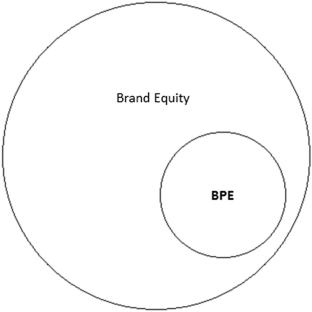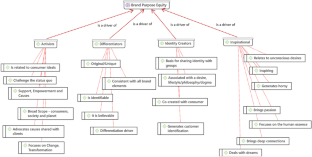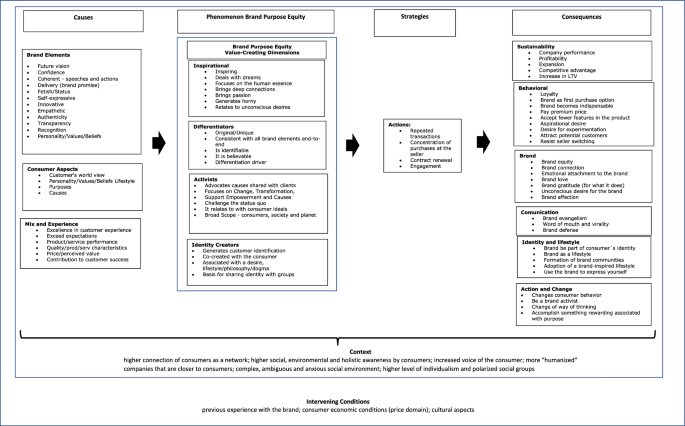Abstract
The brand purpose is a relevant new concept considered and applied by companies. However, the existing research is primarily isolated case studies, highlighting evidence of its application as a generator of value and brand identity. No studies still identify the value of a brand purpose, and there is no theory or concept around this point. In this sense, this research aims to map the theory related to the value of a brand purpose from data analyzed systematically that could reveal the related phenomenon and its relations. An exploratory study of an inductive nature was carried out using Grounded Theory with specialists (practitioners) in marketing. The Atlas. Ti 23 software was selected to carry out the analyses in this study. After completing the open, axial, and selective coding phases, the core phenomenon was identified and entitled brand purpose equity (BPE). Four subcategories of BPE were classified: activists, inspirational, differentiators, and identity creators, suggesting that BPE is a multidimensional construct. This is the first study that offers an exploratory conceptual framework to conceptualize and create a theoretical basis for the value of brand purpose. In this sense, this research paves the way for building the brand purpose value theory and a measurement prototype scale, in addition to allowing the identification of antecedents and consequences of the brand purpose and its impacts on brand equity, representing advances and fundamentals for the development of models and empirical evidence of improvement in this area.

Source Authors

Source Authors
Similar content being viewed by others
Data availability
This qualitative study does not have a dataset, but a set of interviews transcriptions.
References
Aaker, D.A. 1992. The value of brand equity. Journal of Business Strategy 13 (4): 27–32.
Aaker, D.A. 2009. Managing brand equity. Simon and Schuster.
Aaker, D.A. 2012. Building Strong Brands. Simon and Schuster.
Accenture. 2018. From me to we: The rise of the purpose-led brand. https://www.accenture.com/us-en/insights/strategy/brand-purpose. Accessed 26 Nov 2023.
Ball, A.D., and L.H. Tasaki. 1992. The role and measurement of attachment in consumer behavior. Journal of Consumer Psychology 1 (2): 155–172.
Belk, R.W. 1988. Possessions and the extended self. Journal of Consumer Research 15 (2): 139–168.
Calder, B.J. 2022. Customer interaction strategy, brand purpose and brand communities. Journal of Service Management 33 (4–5): 747–757.
Campbell, A., and S. Yeung. 1991. Creating a sense of mission. In Strategy process, content, context—An international perspective, ed. B. De Witt and R. Meyer, 147–156. New York, NY: West Publishing Company.
Campbell, A. 1992. The power of mission: Aligning strategy and culture. Planning Review Special Issue 20 (5): 10–13.
Charmaz, K. 2006. Constructing Grounded Theory practical guide through qualitative analysis. Los Angeles: Sage.
Churchill, G.A., Jr. 1979. A paradigm for developing better measures of marketing constructs. Journal of Marketing Research 16 (1): 64–73.
Corbin, J. 2017. Grounded theory. The Journal of Positive Psychology 12 (3): 301–302.
Delve, L., and A. Limpaecher. 2023. Member check and respondent validation in qualitative research. https://delvetool.com/blog/member-check-respondent-validation. Accessed 3 Nov 2023.
Drucker, P. F. (1986). Innovation and Entrepreneurship. New York: HarperCollins.
EY. 2020. Why business must harness the power of purpose. https://www.ey.com/en_us/purpose/why-business-must-harness-the-power-of-purpose. Accessed 29 Nov 2023.
Gambetti, R.C., G. Graffigna, and S. Biraghi. 2012. The Grounded Theory approach to consumer-brand engagement: The practitioner’s standpoint. International Journal of Market Research 54 (5): 659–687.
Ghodeswar, B.M. 2008. Building brand identity in competitive markets: A conceptual model. Journal of Product & Brand Management 17 (1): 4–12.
Glaser, B. 1978. Theoretical sensitivity. Mill Valley: Sociology Press.
Glaser, B., and A. Strauss. 1967. The discovery of grounded theory. Hawthorne: Aldine Publishing Company.
Hajdas, M., and R. Kłeczek. 2021. The real purpose of purpose-driven branding: Consumer empowerment and social transformations. Journal of Brand Management 28 (4): 359–373.
Hsu, C.-K.J. 2017. Selling products by selling brand purpose. Journal of Brand Strategy 5 (4): 373–394.
Kapferer, J.-N. 2012. The new strategic brand management: Advanced insights and strategic thinking. London: Kogan Page Publishers.
Keller, K.L. 1993. Conceptualizing, measuring, and managing customer-based brand equity. Journal of Marketing 57 (1): 1–22.
Keller, K.L. 2001. Building customer-based brand equity: A blueprint for creating strong brands. Marketing Science Institute 1 (107): 1–38.
Keller, K.L. 2020. Consumer research insights on brands and branding: A JCR curation. Journal of Consumer Research 46 (5): 995–1001.
Kenny, G. 2014. Your company’s purpose is not its vision, mission, or values. Harvard Business Review 3: 285–306.
Kramer, M. 2017. Brand purpose: The navigational code for growth. Journal of Brand Strategy 6 (1): 46–54.
Lokmanoglu, Z. 2019. The Brand Identity Prism: What it is and how to use it. 99Designs. https://99designs.com/blog/resources/brand-identity-prism/. Accessed 30 Oct 2023.
Madhavaram, S., V. Badrinarayanan, and R.E. McDonald. 2005. Integrated marketing communication (IMC) and brand identity as critical components of brand equity strategy: A conceptual framework and research propositions. Journal of Advertising 34 (4): 69–80.
Malnight, T.W., I. Buche, and C. Dhanaraj. 2019. Put purpose at the core of your strategy. Harvard Business Review 97 (5): 70–78.
Mirzaei, A., C.M. Webster, and H. Siuki. 2021. Exploring brand purpose dimensions for non-profit organizations. Journal of Brand Management 28 (2): 186–198.
Morse, J.M. 2009. Mixing qualitative methods. Qualitative Health Research 19 (11): 1523–1524.
Narayanan, S., and J.R. Das. 2021. Can the marketing innovation of purpose branding make brands meaningful and relevant? International Journal of Innovation Science 3/4: 519–536.
Netemeyer, R.G., W.O. Bearden, and S. Sharma. 2003. Scaling procedures: Issues and applications. Thousand Oaks: SAGE.
Parris, D.L., and F. Guzmán. 2023. Evolving brand boundaries and expectations: Looking back on brand equity, brand loyalty, and brand image research to move forward. Journal of Product & Brand Management 32 (2): 191–234.
Reinders, M.J., and J. Bartels. 2017. The roles of identity and brand equity in organic consumption behavior: Private label brands versus national brands. Journal of Brand Management 24 (1): 68–85.
Rust, R.T., and B. Cooil. 1994. Reliability measures for qualitative data: Theory and implications. Journal of Marketing Research 31 (1): 1–14.
Sinek, S. 2009. Start with why: How great leaders inspire everyone to take action. New York: Penguin.
Souki, G.Q., F.B. Chinelato, and C.G. Filho. 2022. Sharing is entertaining: The impact of consumer values on video sharing and brand equity. Journal of Research in Interactive Marketing 16 (1): 118–136.
Srinivasan, V., C.S. Park, and D.R. Chang. 2005. An approach to the measurement, analysis, and prediction of brand equity and its sources. Management Science 51 (9): 1433–1448.
Strauss, A., and J. Corbin. 1990. Basics of qualitative research. Thousand Oaks: SAGE.
Strauss, A., and Corbin, J. 1998. Basics of qualitative research techniques.
Strauss, A., and J. Corbin. 2008. Basics of qualitative research techniques and procedures for developing grounded theory. Thousand Oaks: SAGE.
Vollstedt, M., and S. Rezat. 2019. An introduction to grounded theory with a special focus on axial coding and the coding paradigm. Compendium for Early Career Researchers in Mathematics Education 13 (1): 81–100.
Vredenburg, J., S. Kapitan, A. Spry, and J.A. Kemper. 2020. Brands taking a stand: Authentic brand activism or woke washing? Journal of Public Policy & Marketing 39 (4): 444–460.
Yoo, B., and N. Donthu. 2001. Developing and validating a multidimensional consumer-based brand equity scale. Journal of Business Research 52 (1): 1–14.
Author information
Authors and Affiliations
Corresponding author
Additional information
Publisher's Note
Springer Nature remains neutral with regard to jurisdictional claims in published maps and institutional affiliations.
Appendices
Appendix 1: Category and subcategories—according to Strauss and Corbin (1990) paradigm
See Fig. 1.

Appendix 2: Prototype of Brand Purpose Equity Scale—Drivers (dimensions) and items candidates
Drivers (dimensions) | Items candidates |
|---|---|
Inspirational | Inspiring |
Deals with dreams | |
Focuses on the human essence | |
Brings deep connections | |
Brings passion | |
Generates horny | |
Relates to unconscious desires | |
Differentiators | Original/Unique |
Consistent with all brand elements end-to-end | |
Is identifiable | |
It is believable | |
Differentiation driver | |
Activists | Advocates causes shared with clients |
Focuses on Change, Transformation, | |
Support, Empowerment and Causes | |
Challenge the status quo | |
It relates to with consumer ideals | |
Broad Scope—consumers, society, and planet | |
Identity Creators | Generates customer identification |
Co-created with the consumer | |
Associated with a desire, lifestyle/philosophy/dogma | |
Basis for sharing identity with groups |
Source Data research
Rights and permissions
Springer Nature or its licensor (e.g. a society or other partner) holds exclusive rights to this article under a publishing agreement with the author(s) or other rightsholder(s); author self-archiving of the accepted manuscript version of this article is solely governed by the terms of such publishing agreement and applicable law.
About this article
Cite this article
Gonçalves Filho, C., Chinelato, F.B. & Prado, F.V. The grounded theory approach to brand purpose equity drivers: the practitioner’s perspective. J Market Anal (2024). https://doi.org/10.1057/s41270-023-00277-9
Revised:
Accepted:
Published:
DOI: https://doi.org/10.1057/s41270-023-00277-9




